Applied Physics
Vol.06 No.04(2016), Article ID:17440,8
pages
10.12677/APP.2016.64012
Complex Dynamic Mass Density in Acoustic Metamaterials
Guanghao Wang, Ping Bai, Jie Luo, Yun Lai*
Collaborative Innovation Center of Suzhou Nano Science and Technology, College of Physics, Optoelectronics and Energy, Soochow University, Suzhou Jiangsu

Received: Apr. 6th, 2016; accepted: Apr. 21st, 2016; published: Apr. 27th, 2016
Copyright © 2016 by authors and Hans Publishers Inc.
This work is licensed under the Creative Commons Attribution International License (CC BY).
http://creativecommons.org/licenses/by/4.0/



ABSTRACT
The mass density of normal acoustic materials is usually a real number. Energy dissipation is induced by the volume or shape change of the materials, which relates to the imaginary parts of complex moduli. Here, we show that by using acoustic metamaterials, complex dynamic mass density can also be realized. In this case, energy dissipation is induced by the change of momentum of the material. We analyze the physical origin of such complex mass density and provide a theoretical approach to calculate the effective complex dynamic mass density for acoustic metamaterials with dissipation. The obtained effective complex mass density is verified by finite element simulations, including both transmission studies and realization of coherent perfect absorption. Our work shows a way to realize complex mass density, which has important applications in enhancing absorption of acoustic waves.
Keywords:Acoustic Metamaterial, Dynamic Mass Density, Dissipation

声学超材料的复数动态质量密度
王广浩,柏萍,罗杰,赖耘*
苏州大学物理与光电·能源学部,苏州纳米科技协同创新中心,江苏 苏州

收稿日期:2016年4月6日;录用日期:2016年4月21日;发布日期:2016年4月27日

摘 要
在普通的声学材料中,质量密度通常是一个实数。能量耗散是由材料的形状或体积变化引起的,这与复数模量的虚部有关。这里,我们利用声学超材料也可以实现复数的动态质量密度。在这种情况下,能量损耗是由材料的动量变化引起的。我们分析了这种复数的动态质量密度的物理成因,并提出了计算这种有损耗的声学超材料的复数动态质量密度的理论方法。得到的有效复数质量密度通过有限元模拟进行了验证,包括传输研究和实现相干完美吸收。我们的工作展示了一种实现复数质量密度的方法,这找提高声波的吸收上有重要的应用。
关键词 :声学超材料,动态质量密度,损耗

1. 引言
在过去的一个世纪中,声波的吸收由于具有重要应用价值被广泛地研究。例如噪声控制,混响设计等。最近,声学超材料的出现给我们控制声波的吸收提供了一个新的机遇 [1] - [11] 。通过设计适当的局域共振结构,声学超材料可以呈现几乎任意的有效参数,包括负的质量密度 [1] [4] [5] 、负的体积模量 [3] 、负的剪切模量 [6] 、双负 [2] [6] - [9] 和其他不同寻常的密度和模量组成 [10] [11] 。拥有如此不同寻常参数的超材料,不仅可以在超透和高透镜 [12] - [15] ,隐身斗篷和声学幻像 [16] - [27] 上产生新的应用,而且可以极大地提高声波的吸收 [28] - [40] 。特别是,薄膜超材料已经在亚波长尺度实现了对声波的宽频吸收和全吸收 [28] - [30] 。声学相干完美吸收 [32] [33] 的概念和一个声学薄膜实现宽带完美的吸收 [31] 的理论已经被提出。科研工作者们也已经对声学多孔片状晶体 [34] [35] 和其他结构如声学黑洞 [36] - [39] 进行了研究。这些令人兴奋的发现导致了新的声学吸收技术的快速发展。
在普通的声学材料中,质量密度通常是一个实数。损耗与复数的模量有关,表明能量耗散是由材料的形状或体积变化引起的。这是由材料中相对的位移(形状或体积变化)引起的直观的摩擦(损耗的起源)产生的。然而,声学超材料为实现一种非直观的吸收提供了新的可能性,即损耗和复数的动态质量密度有关。这种复数的动态质量密度不仅代表了损耗的另外一种机制,而且还可以支持一些有趣的应用,如声学相干完美吸收 [32] [33] 。特别是,最近的超薄膜组成的纯虚数的质量密度与特定的分散体被发现在自由边界条件下支持声波的宽带完美吸收 [31] 。这样的宽带完美的吸收非常依赖质量密度,但对于弹性模量和速度的要求具有很大的自由度。这些研究结果表明了研究复数的质量密度的重要意义。在这项工作中,我们分析了这种复数的动态质量密度的物理成因,并提出了计算声学超材料的复数的动态质量密度的理论方法。通过对传输特性进行数值研究,实现了相干完美吸收。由此我们证明了该方法的有效性。
2. 计算声学超材料的复数的动态质量密度的理论方法
我们从一个简单的正方晶格弹性超材料出发,它是由铅柱子外包围着一层硅橡胶然后镶嵌在环氧树脂基体中。晶格常数是10 cm;铅柱的半径是3 cm;外围着的硅橡胶的半径是4 cm。环氧树脂的参数分别是 ,
, ,
, ;硅橡胶的参数分别是
;硅橡胶的参数分别是 ,
, ,
, ;铅的参数分别是
;铅的参数分别是 ,
, ,
, (
( 是密度,
是密度, 是杨氏模量,
是杨氏模量, 是泊松比)。对于这样一个声学超材料,我们基于有限元方法用COMSOL多物理场耦合软件计算出了它的能带结构,如图1所示。很显然,在频率大约300 Hz到700 Hz之间存在一个大的完全带隙,这是由晶格的局域偶极共振引起的。这个带隙是由偶极共振产生的负的动态质量密度导致的。
是泊松比)。对于这样一个声学超材料,我们基于有限元方法用COMSOL多物理场耦合软件计算出了它的能带结构,如图1所示。很显然,在频率大约300 Hz到700 Hz之间存在一个大的完全带隙,这是由晶格的局域偶极共振引起的。这个带隙是由偶极共振产生的负的动态质量密度导致的。
现在,我们在硅橡胶层里加入损耗,而实际情况也经常是这样。为了简单起见,我们把硅橡胶的杨氏模量变成 。在这种情况下,我们照样可以计算给定波矢
。在这种情况下,我们照样可以计算给定波矢 对应的本征频率,但是本征频率通常都是复数值。在图2(a)和(b)中,我们展示了在频率高于700 Hz的纵向偶极模态中,在
对应的本征频率,但是本征频率通常都是复数值。在图2(a)和(b)中,我们展示了在频率高于700 Hz的纵向偶极模态中,在 的虚部为零的情况下本征频率的实部和虚部和
的虚部为零的情况下本征频率的实部和虚部和 的关系图,显然,本征频率是有虚部的。这样的虚部表示能量随着时间消逝。
的关系图,显然,本征频率是有虚部的。这样的虚部表示能量随着时间消逝。
在这项工作中,我们想要研究的是传输特性而不是瞬态。为了避免波衰逝在时间上,一个方法就是让它消逝在空间上。在图2(c)和(d)中,我们采用了复数的波矢而不是纯实数的波矢。波矢的实部固定为 。有趣的是,当波矢的虚部逐渐增大的时候,本征频率的虚部会相应地变小。在图2(d)中,红点处对应的是
。有趣的是,当波矢的虚部逐渐增大的时候,本征频率的虚部会相应地变小。在图2(d)中,红点处对应的是 ,对应的本征频率的虚部为零,这表明在时间里的衰逝完全转移到空间里。这正是传输研究中的情况。在图2(c)中,我们可以看到纯实数本征频率仅仅比之前
,对应的本征频率的虚部为零,这表明在时间里的衰逝完全转移到空间里。这正是传输研究中的情况。在图2(c)中,我们可以看到纯实数本征频率仅仅比之前 有吸收时稍微小一些。图2(e)图(e)展示的是在保证本征频率为纯实数情况下,
有吸收时稍微小一些。图2(e)图(e)展示的是在保证本征频率为纯实数情况下, 的实部和虚部和频率的关系图。
的实部和虚部和频率的关系图。
联系到纯实数的本征频率,我们同样得到了相应的衰逝本征场 [10] 。通过分析晶胞每个边界上的应力,应变和位移,我们可以得到相应的动态有效质量密度 和有效体积模量
和有效体积模量 。此外,晶格常数为a的二维正方晶格的动态有效质量密度
。此外,晶格常数为a的二维正方晶格的动态有效质量密度 和有效体积模量
和有效体积模量 可以通过以下公式得到:
可以通过以下公式得到:
 (1)
(1)
和
 (2)
(2)
其中有效的力和位移可以通过 和
和 得到;有效张量
得到;有效张量 和有效应力
和有效应力 可以通过
可以通过 ,
, ,
, ,
, ,
, ,
, 和
和 得到。
得到。
在图3中,我们展示了得到的有效参数 和
和 。在图3中,我们可以看到有效体积模量
。在图3中,我们可以看到有效体积模量 的实部数量级是
的实部数量级是 ,而虚部是
,而虚部是 ,虚部比实部小几个数量级。因此,尽管我们已经在硅橡胶层里加入了损耗,有效体积模量几乎仍然是纯实数。在另一方面,在图3(b)中,我们可以看到有效质量
,虚部比实部小几个数量级。因此,尽管我们已经在硅橡胶层里加入了损耗,有效体积模量几乎仍然是纯实数。在另一方面,在图3(b)中,我们可以看到有效质量 的虚部只比实部小一个数量级。特别是在频率700 Hz附近,有效质量
的虚部只比实部小一个数量级。特别是在频率700 Hz附近,有效质量 的实部是接近于零的,同时有效质量的虚部不为零。因此,在频率700 Hz左右有效质量是接近于纯虚数的。这里的结果表明,可以通过在偶极共振中加入少量的损耗来获得复数的质量密度。通过偶极共振,在质量密度中的损耗(即虚部)可以
的实部是接近于零的,同时有效质量的虚部不为零。因此,在频率700 Hz左右有效质量是接近于纯虚数的。这里的结果表明,可以通过在偶极共振中加入少量的损耗来获得复数的质量密度。通过偶极共振,在质量密度中的损耗(即虚部)可以
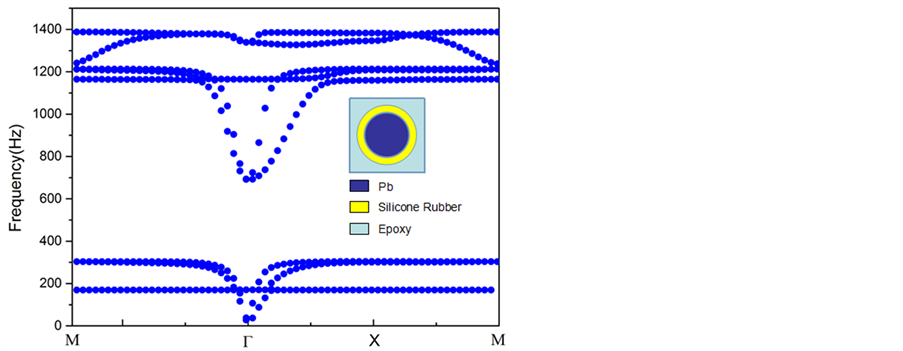
Figure 1. The band structure of the elastic metamaterial (inset graph)
图1. 弹性超材料的能带结构(如插图所示)
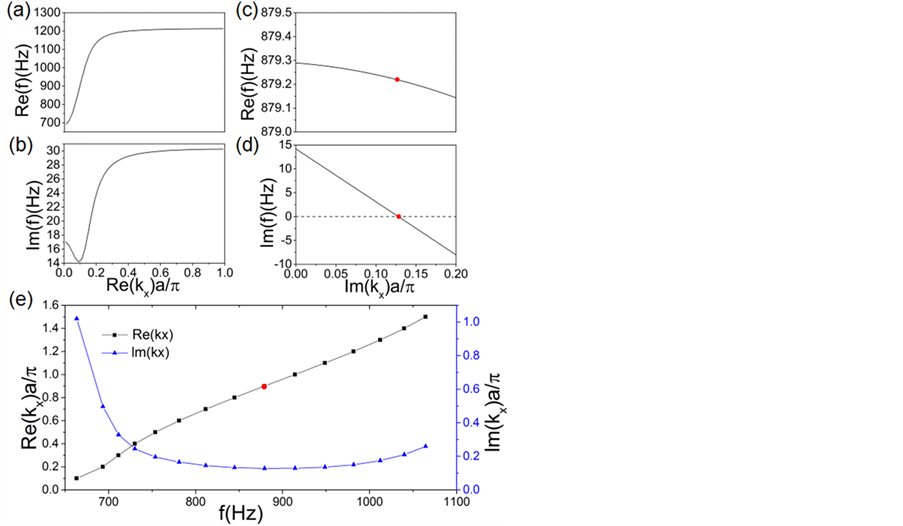
Figure 2. (a) and (b) shows the real and imaginary parts of the complex eigen-frequency  as functions of the real wave vector for the longitudinal dipolar mode, respectively. Loss is added in the silicone rubber coatings by changing the modulus to be
as functions of the real wave vector for the longitudinal dipolar mode, respectively. Loss is added in the silicone rubber coatings by changing the modulus to be . (b) and (d) shows the real and imaginary parts of the complex eigen-frequency
. (b) and (d) shows the real and imaginary parts of the complex eigen-frequency  as functions of the imaginary part of the wave vector
as functions of the imaginary part of the wave vector  for a given real part of
for a given real part of , respectively. Apparently, with increase in
, respectively. Apparently, with increase in , the
, the  decreases gradually. At the point of
decreases gradually. At the point of  (marked by a red dot in (d) and (e)), the eigen-frequency turn into a purely real number
(marked by a red dot in (d) and (e)), the eigen-frequency turn into a purely real number . (e) The real part and imaginary parts of
. (e) The real part and imaginary parts of  that are required for eigen-frequencies f to be purely real
that are required for eigen-frequencies f to be purely real
图2. (a)和(b)分别表示在纵向偶极模态中 的虚部为零的情况下本征频率的实部和虚部和
的虚部为零的情况下本征频率的实部和虚部和 的关系图。(c)和(d)分别表示在
的关系图。(c)和(d)分别表示在 的实部为
的实部为 时,本征频率的实部和虚部与
时,本征频率的实部和虚部与 的虚部的关系图。显然,本征频率的实部和虚部随着
的虚部的关系图。显然,本征频率的实部和虚部随着 的虚部变大逐渐变小。在点
的虚部变大逐渐变小。在点 (如图中红点所示),本征频率变成一个纯实数值。图(e)是在保证本征频率为纯实数情况下,
(如图中红点所示),本征频率变成一个纯实数值。图(e)是在保证本征频率为纯实数情况下, 的实部和虚部和频率的关系图
的实部和虚部和频率的关系图
被大大提高。特别是,在特定的频率,质量密度是实部为零,从而实现纯虚数的质量密度。这样一个纯虚数的质量密度可以在提高吸收上有重要的应用 [31] 。
接下来,我们运用数值模拟(通过利用基于有限元方法的多物理场耦合软件COMSOL)来证明的有效参数的有效性。首先,我们研究了传输特性。在图4中,我们研究了透射率和反射率和样品厚度的变化关系图。我们选择了波矢 对应着的频率为693.25 Hz这点,这点对应着的有效参数为有效体积模量
对应着的频率为693.25 Hz这点,这点对应着的有效参数为有效体积模量 和有效质量密度
和有效质量密度 。很明显,得到的动态质量密
。很明显,得到的动态质量密
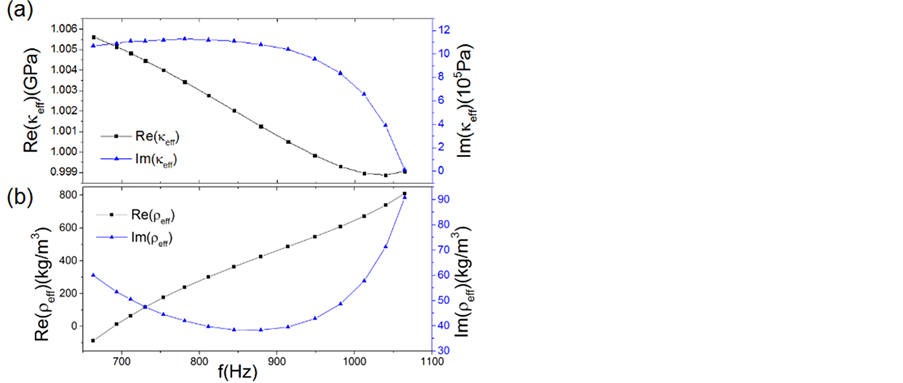
Figure 3. (a) The obtained  for the band of dipolar longitudinal mode; (b) The obtained
for the band of dipolar longitudinal mode; (b) The obtained  for the band of dipolar longitudinal mode. The longitudinal coordinates of the left are the real part of the effective parameters and the longitudinal coordinates of the right are the imaginary part of the effective parameters
for the band of dipolar longitudinal mode. The longitudinal coordinates of the left are the real part of the effective parameters and the longitudinal coordinates of the right are the imaginary part of the effective parameters
图3. (a) 通过偶极纵向模态的能带得到的有效体积模量 ;(b) 通过偶极纵向模态的能带得到的有效质量密度
;(b) 通过偶极纵向模态的能带得到的有效质量密度 。左边的纵坐标对应着有效参数的实部,右边的纵坐标对应着有效参数的虚部
。左边的纵坐标对应着有效参数的实部,右边的纵坐标对应着有效参数的虚部
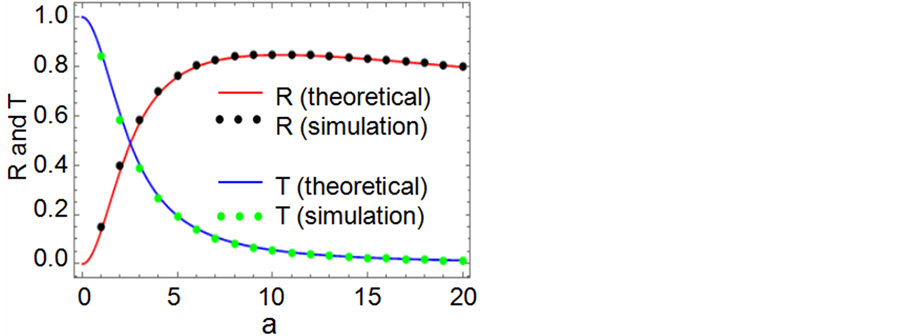
Figure 4. Reflection and transmission rates as a function of the sample thickness
图4. 反射率和透射率随着样品的厚度变化关系图
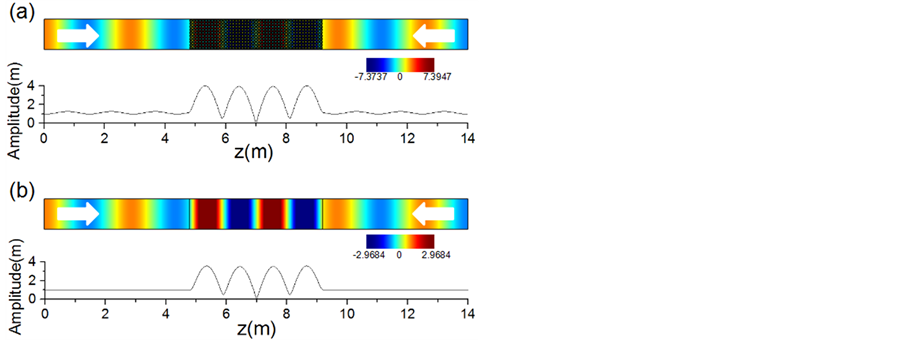
Figure 5. Snapshots and amplitude distributions for displacements obtained for both the metamaterial sample and the effective medium, under two beams with opposite phases incident from the left and the right. The background medium is epoxy
图5. 左右两束反相位的波同时入射时,超材料样品和有效介质的图像和振幅分布图。背景是环氧树脂
度为复数,而且虚部比实部大得多。图4的是用有效参数得到的理论上的反射和透射曲线,而图上的点是用超材料样品仿真模拟得到。很明显,理论和仿真模拟的结果吻合的很好,说明了所得到的有效参数的准确性。
最后,我们利用复数动态质量密度的声学超材料来演示相干完美吸收。我们想到从左右两侧同时入射两束反相位的波。我们证明了只要材料具有合适的参数,入射波是会被全部吸收的 [33] 。这就意味着实现了相干完美吸收 [41] [42] 。在图5(a)和5(b)中,我们展示了超材料样品和有效介质的图像和振幅分布图。超材料样品和有效介质的宽和高相同,分别是 和
和 。在频率
。在频率 下,波矢
下,波矢 ,对应着的有效质量密度和体积模量分别是
,对应着的有效质量密度和体积模量分别是 和
和 。背景里的振幅几乎是一致的,这表明背景里几乎没有反射波,即了实现波的相干完美吸收。此外,在超材料样品中包络的场的形状几乎是和有效介质中的一样。
。背景里的振幅几乎是一致的,这表明背景里几乎没有反射波,即了实现波的相干完美吸收。此外,在超材料样品中包络的场的形状几乎是和有效介质中的一样。
3. 结论
总之,我们研究了声学超材料复数的质量密度的物理起源,即偶极共振和耗散,提出了一种计算声学超材料复数的动态质量密度的有效方法。通过对传输特性和一个相干完美吸收的例子的数值模拟,方法的有效性已被成功验证。复数的动态质量密度意味着损耗是由材料的动量变化引起的,并且在实现声波的宽带完美吸收中有着重要的应用 [28] - [33] 。
基金项目
以上工作是由中国国家重点基础研究项目(编号2014cb360505,2012cb921501号),国家自然科学基金(编号:11374224)支持,并通过江苏高等教育机构的优势学科建设项目资助(PAPD)。
文章引用
王广浩,柏 萍,罗 杰,赖 耘. 声学超材料的复数动态质量密度
Complex Dynamic Mass Density in Acoustic Metamaterials[J]. 应用物理, 2016, 06(04): 83-90. http://dx.doi.org/10.12677/APP.2016.64012
参考文献 (References)
- 1. Liu, Z., Zhang, X., Mao, Y., Zhu, Y.Y., Yang, Z., Chan, C.T. and Sheng, P. (2000) Locally Resonant Sonic Materials. Science, 289, 1734-1736. http://dx.doi.org/10.1126/science.289.5485.1734
- 2. Li, J. and Chan, C. (2004) Double-Negative Acoustic Metamaterial. Physical Review E, 70, Article ID: 055602. http://dx.doi.org/10.1103/PhysRevE.70.055602
- 3. Fang, N., Xi, D., Xu, J., Ambati, M., Srituravanich, W., Sun, C. and Zhang, X. (2006) Ultrasonic Metamaterials with Negative Modulus. Nature Materials, 5, 452-456. http://dx.doi.org/10.1038/nmat1644
- 4. Yang, Z., Mei, J., Yang, M., Chan, N. and Sheng, P. (2008) Membrane-Type Acoustic Metamaterial with Negative Dynamic Mass. Physical Review Letters, 101, Article ID: 204301. http://dx.doi.org/10.1103/PhysRevLett.101.204301
- 5. Pierre, J., Dollet, B. and Leroy, V. (2014) Resonant Acoustic Propagation and Negative Density in Liquid Foams. Physical Review Letters, 112, Article ID: 148307. http://dx.doi.org/10.1103/PhysRevLett.112.148307
- 6. Wu, Y., Lai, Y. and Zhang, Z. (2011) Elastic Metamaterials with Simultaneously Negative Effective Shear Modulus and Mass Density. Physical Review Letters, 107, Article ID: 105506. http://dx.doi.org/10.1103/PhysRevLett.107.105506
- 7. Ding, Y., Liu, Z., Qiu, C. and Shi, J. (2007) Metamaterial with Simultaneously Negative Bulk Modulus and Mass Density. Physical Review Letters, 99, Article ID: 093904. http://dx.doi.org/10.1103/PhysRevLett.99.093904
- 8. Lee, S.H., Park, C.M., Seo, Y.M., Wang, Z.G. and Kim, C.K. (2010) Composite Acoustic Medium with Simultaneously Negative Density and Modulus. Physical Review Letters, 104, Article ID: 054301. http://dx.doi.org/10.1103/PhysRevLett.104.054301
- 9. Yang, M., Ma, G., Yang, Z. and Sheng, P. (2013) Coupled Membranes with Doubly Negative Mass Density and Bulk Modulus. Physical Review Letters, 110, Article ID: 134301. http://dx.doi.org/10.1103/PhysRevLett.110.134301
- 10. Lai, Y., Wu, Y., Sheng, P. and Zhang, Z.Q. (2011) Hybrid Elastic Solids. Nature Materials, 10, 620-624. http://dx.doi.org/10.1038/nmat3043
- 11. Liang, Z. and Li, J. (2012) Extreme Acoustic Metamaterial by Coiling up Space. Physical Review Letters, 108, Article ID: 114301. http://dx.doi.org/10.1103/PhysRevLett.108.114301
- 12. Li, J., Fok, L., Yin, X., Bartal, G. and Zhang, X. (2009) Experimental Demonstration of an Acoustic Magnifying Hyperlens. Nature Materials, 8, 931-934. http://dx.doi.org/10.1038/nmat2561
- 13. Ao, X. and Chan, C.T. (2008) Far-Field Image Magnification for Acoustic Waves Using Anisotropic Acoustic Metamaterials. Physical Review E, 77, Article ID: 025601(R). http://dx.doi.org/10.1103/PhysRevE.77.025601
- 14. García-Chocano, V.M., Christensen, J. and Sánchez-Dehesa, J. (2014) Negative Refraction and Energy Funneling by Hyperbolic Materials: An Experimental Demonstration in Acoustics. Physical Review Letters, 112, Article ID: 144301. http://dx.doi.org/10.1103/PhysRevLett.112.144301
- 15. Zhu, J., Christensen, J., Jung, J., Martin-Moreno, L., Yin, X., Fok, L., Zhang, X. and Garcia-Vidal, F.J. (2010) A Holey-Structured Metamaterial for Acoustic Deep-Subwavelength Imaging. Nature Physics, 7, 52-55. http://dx.doi.org/10.1038/nphys1804
- 16. Milton, G.W., Briane, M. and Willis, J.R. (2006) On Cloaking for Elasticity and Physical Equations with a Transformation Invariant Form. New Journal of Physics, 8, 248-248. http://dx.doi.org/10.1088/1367-2630/8/10/248
- 17. Chen, H. and Chan, C.T. (2007) Acoustic Cloaking in Three Dimensions Using Acoustic Metamaterials. Applied Physics Letters, 91, Article ID: 183518. http://dx.doi.org/10.1063/1.2803315
- 18. Farhat, M., Enoch, S., Guenneau, S. and Movchan, A. (2008) Broadband Cylindrical Acoustic Cloak for Linear Surface Waves in a Fluid. Physical Review Letters, 101, Article ID: 134501. http://dx.doi.org/10.1103/PhysRevLett.101.134501
- 19. Cummer, S., Popa, B., Schurig, D., Smith, D., Pendry, J., Rahm, M. and Starr, A. (2008) Scattering Theory Derivation of a 3D Acoustic Cloaking Shell. Physical Review Letters, 100, Article ID: 024301. http://dx.doi.org/10.1103/PhysRevLett.100.024301
- 20. Farhat, M., Guenneau, S. and Enoch, S. (2009) Ultrabroadband Elastic Cloaking in Thin Plates. Physical Review Letters, 103, Article ID: 024301. http://dx.doi.org/10.1103/PhysRevLett.103.024301
- 21. Zhu, X., Liang, B., Kan, W., Zou, X. and Cheng, J. (2011) Acoustic Cloaking by a Superlens with Single-Negative Materials. Physical Review Letters, 106, Article ID: 014301. http://dx.doi.org/10.1103/PhysRevLett.106.014301
- 22. Zhang, S., Xia, C. and Fang, N. (2011) Broadband Acoustic Cloak for Ultrasound Waves. Physical Review Letters, 106, Article ID: 024301. http://dx.doi.org/10.1103/PhysRevLett.106.024301
- 23. Popa, B., Zigoneanu, L. and Cummer, S.A. (2011) Experimental Acoustic Ground Cloak in Air. Physical Review Letters, 106, Article ID: 253901. http://dx.doi.org/10.1103/PhysRevLett.106.253901
- 24. Stenger, N., Wilhelm, M. and Wegener, M. (2012) Experiments on Elastic Cloaking in Thin Plates. Physical Review Letters, 108, Article ID: 014301. http://dx.doi.org/10.1103/PhysRevLett.108.014301
- 25. Buckmann, T., Thiel, M., Kadic, M., Schittny, R. and Wegener, M. (2014) An Elasto-Mechanical Unfeelability Cloak Made of Pentamode Metamaterials. Nature Communications, 5, Article No. 4130. http://dx.doi.org/10.1038/ncomms5130
- 26. Sanchis, L., García-Chocano, V., Llopis-Pontiveros, R., Climente, A., Martínez-Pastor, J., Cervera, F. and Sánchez- Dehesa, J. (2013) Three-Dimensional Axisymmetric Cloak Based on the Cancellation of Acoustic Scattering from a Sphere. Physical Review Letters, 110, Article ID: 124301. http://dx.doi.org/10.1103/PhysRevLett.110.124301
- 27. Zigoneanu, L., Popa, B.I. and Cummer, S.A. (2014) Three-Dimensional Broadband Omnidirectional Acoustic Ground Cloak. Nature Materials, 13, 352-355. http://dx.doi.org/10.1038/nmat3901
- 28. Mei, J., Ma, G., Yang, M., Yang, Z., Wen, W. and Sheng, P. (2012) Dark Acoustic Metamaterials as Super Absorbers for Low-Frequency Sound. Nature Communications, 3, Article No. 756. http://dx.doi.org/10.1038/ncomms1758
- 29. Ma, G., Yang, M., Xiao, S., Yang, Z. and Sheng, P. (2014) Acoustic Metasurface with Hybrid Resonances. Nature Materials, 13, 873-878. http://dx.doi.org/10.1038/nmat3994
- 30. Yang, M., Meng, C., Fu, C., Li, Y., Yang, Z. and Sheng, P. (2015) Subwavelength Total Acoustic Absorption with Degenerate Resonators. Applied Physics Letters, 107, Article ID: 104104. http://dx.doi.org/10.1063/1.4930944
- 31. Duan, Y., Luo, J., Wang, G., Hang, Z.H., Hou, B., Li, J., Sheng, P. and Lai, Y. (2015) Theoretical Requirements for Broadband Perfect Absorption of Acoustic Waves by Ultra-Thin Elastic Meta-Films. Scientific Reports, 5, Article No. 12139. http://dx.doi.org/10.1038/srep12139
- 32. Song, J.Z., Bai, P., Hang, Z.H. and Lai, Y. (2014) Acoustic Coherent Perfect Absorbers. New Journal of Physics, 16, Article ID: 033026. http://dx.doi.org/10.1088/1367-2630/16/3/033026
- 33. Wei, P., Croënne, C., Tak Chu, S. and Li, J. (2014) Symmetrical and Anti-Symmetrical Coherent Perfect Absorption for Acoustic Waves. Applied Physics Letters, 104, Article ID: 121902. http://dx.doi.org/10.1063/1.4869462
- 34. Christensen, J. and Willatzen, M. (2014) Acoustic Wave Propagation and Stochastic Effects in Metamaterial absorberS. Applied Physics Letters, 105, Article ID: 043508. http://dx.doi.org/10.1063/1.4892011
- 35. Christensen, J., Romero-Garcia, V., Pico, R., Cebrecos, A., de Abajo, F.J., Mortensen, N.A., Willatzen, M. and Sanchez-Morcillo, V.J. (2014) Extraordinary Absorption of Sound in Porous Lamella-Crystals. Scientific Reports, 4, Article No. 4674. http://dx.doi.org/10.1038/srep04674
- 36. Li, R., Zhu, X., Liang, B., Li, Y., Zou, X. and Cheng, J. (2011) A Broadband Acoustic Omnidirectional Absorber Comprising Positive-Index Materials. Applied Physics Letters, 99, Article ID: 193507. http://dx.doi.org/10.1063/1.3659690
- 37. Wei, Q., Cheng, Y. and Liu, X.J. (2012) Acoustic Omnidirectional Superabsorber with Arbitrary Contour. Applied Physics Letters, 100, Article ID: 094105. http://dx.doi.org/10.1063/1.3690899
- 38. Climente, A., Torrent, D. and Sánchez-Dehesa, J. (2012) Omnidirectional Broadband Acoustic Absorber Based on Metamaterials. Applied Physics Letters, 100, Article ID: 144103. http://dx.doi.org/10.1063/1.3701611
- 39. Naify, C.J., Martin, T.P., Layman, C.N., Nicholas, M., Thangawng, A.L., Calvo, D.C. and Orris, G.J. (2014) Underwater Acoustic Omnidirectional Absorber. Applied Physics Letters, 104, Article ID: 073505. http://dx.doi.org/10.1063/1.4865480
- 40. Romero-García, V., Theocharis, G., Richoux, O., Merkel, A., Tournat, V. and Pagneux, V. (2016) Perfect and Broadband Acoustic Absorption by Critically Coupled Sub-Wavelength Resonators. Scientific Reports, 6, Article No. 19519. http://dx.doi.org/10.1038/srep19519
- 41. Longhi, S. (2010) PT-Symmetric Laser Absorber. Physical Review A, 82, Article ID: 031801(R). http://dx.doi.org/10.1103/PhysRevA.82.031801
- 42. Chong, Y.D., Ge, L., Cao, H. and Stone, A.D. (2010) Coherent Perfect Absorbers: Time-Reversed Lasers. Physical Review Letters, 105, Article ID: 053901. http://dx.doi.org/10.1103/PhysRevLett.105.053901